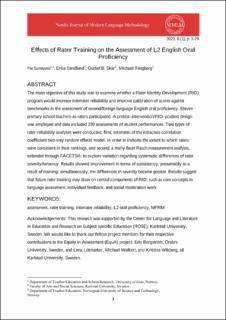| dc.contributor.author | Sundqvist, Pia | |
| dc.contributor.author | Sandlund, Erica | |
| dc.contributor.author | Skar, Gustaf Bernhard Uno | |
| dc.contributor.author | Tengberg, Michael | |
| dc.date.accessioned | 2021-02-11T07:50:17Z | |
| dc.date.available | 2021-02-11T07:50:17Z | |
| dc.date.created | 2020-07-12T11:27:23Z | |
| dc.date.issued | 2020 | |
| dc.identifier.citation | Nordic Journal of Modern Language Methodology. 2020, 8 (1), 3-29. | en_US |
| dc.identifier.issn | 1894-2245 | |
| dc.identifier.uri | https://hdl.handle.net/11250/2727310 | |
| dc.description.abstract | The main objective of this study was to examine whether a Rater Identity Development (RID) program would increase interrater reliability and improve calibration of scores against benchmarks in the assessment of second/foreign language English oral proficiency. Eleven primary school teachers-as-raters participated. A pretest–intervention/RID–posttest design was employed and data included 220 assessments of student performances. Two types of rater-reliability analyses were conducted: first, estimates of the intraclass correlation coefficient two-way random effects model, in order to indicate the extent to which raters were consistent in their rankings, and second, a many-facet Rasch measurement analysis, extended through FACETS®, to explore variation regarding systematic differences of rater severity/leniency. Results showed improvement in terms of consistency, presumably as a result of training; simultaneously, the differences in severity became greater. Results suggest that future rater training may draw on central components of RID, such as core concepts in language assessment, individual feedback, and social moderation work. | en_US |
| dc.language.iso | eng | en_US |
| dc.publisher | Department of Foreign Languages and Translation, U | en_US |
| dc.rights | Navngivelse 4.0 Internasjonal | * |
| dc.rights.uri | http://creativecommons.org/licenses/by/4.0/deed.no | * |
| dc.title | Effects of Rater Training on the Assessment of L2 English Oral Proficiency | en_US |
| dc.type | Peer reviewed | en_US |
| dc.type | Journal article | en_US |
| dc.description.version | publishedVersion | en_US |
| dc.source.pagenumber | 3-29 | en_US |
| dc.source.volume | 8 | en_US |
| dc.source.journal | Nordic Journal of Modern Language Methodology | en_US |
| dc.source.issue | 1 | en_US |
| dc.identifier.doi | https://doi.org/10.46364/njmlm.v8i1.605 | |
| dc.identifier.cristin | 1819259 | |
| dc.description.localcode | Open Access This article is licensed under a Creative Commons Attribution 4.0 International License, which permits use, sharing, adaptation, distribution and reproduction in any medium or format, as long as you give appropriate credit to the original author(s) and the source, provide a link to the Creative Commons licence, and indicate if changes were made. The images or other third party material in this article are included in the article's Creative Commons licence, unless indicated otherwise in a credit line to the material. If material is not included in the article's Creative Commons licence and your intended use is not permitted by statutory regulation or exceeds the permitted use, you will need to obtain permission directly from the copyright holder. To view a copy of this licence, visit http://creativecommons.org/licenses/by/4.0/. | en_US |
| cristin.ispublished | true | |
| cristin.fulltext | original | |
| cristin.qualitycode | 1 | |

